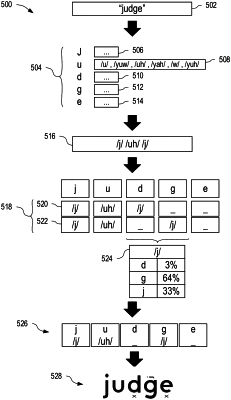| CPC G10L 13/08 (2013.01) [G10L 13/04 (2013.01)] | 20 Claims |

|
1. A method, comprising:
presenting, on a computing device, an interface, wherein presenting the interface includes presenting an input box;
receiving input text via the interface, wherein the input text comprises a string of original graphemes in an original alphabet, the string of original graphemes having a length of n original graphemes of the original alphabet, n being greater than one, and wherein receiving the input text includes receiving the input text via the input box;
providing the input text to a translation module of the computing device;
analyzing the provided input text to generate a string of grapheme-phoneme combinations from the string of original graphemes, the string of grapheme-phoneme combinations having a length of n grapheme-phoneme combinations, wherein generating the string of grapheme-phoneme combinations includes, for each grapheme of the original graphemes, identifying a single respective phoneme associated with the original grapheme, wherein the input text contains a word having letters, and wherein generating the string of grapheme-phoneme combinations from the string of original graphemes further includes:
accessing a phonetic spelling database containing a plurality of phonetic spellings associated with a plurality of words to retrieve a phonetic spelling for the word, the phonetic spelling containing a string of phonemes associated with the word; and
applying the phonetic spelling to the string of original graphemes to identify a valid grapheme-phoneme spelling for the word, wherein applying the phonetic spelling to the string of original graphemes to identify the valid grapheme-phoneme spelling for the word further includes:
identifying, for each letter of the word, a set of allowable phonemes associated with the letter;
generating one or more valid grapheme-phoneme spellings for the word, wherein generating a valid grapheme-phoneme spelling for the word includes identifying, for each combination of each letter of the word and each phoneme of the string of phonemes, a match between the given phoneme and the set of allowable phonemes associated with the given letter;
outputting a first at least one of the one or more valid grapheme-phoneme spellings via the input box;
presenting a variation indicator in association with the outputted first one of the one or more valid grapheme-phoneme spellings, wherein the variation indicator is indicative that the one or more valid grapheme-phoneme spellings includes at least a second one of the one or more valid grapheme-phoneme spellings;
receiving user input indicative of hovering over or clicking the variation indicator or the first one of the one or more valid grapheme-phoneme spellings;
automatically presenting, in response to receiving the user input, the second one of the one or more valid grapheme-phoneme spellings;
receiving additional user input indicative of a selection of the second one of the one or more valid grapheme-phoneme spellings; and
selecting, in response to receiving the additional user input, the second one of the one or more valid grapheme-phoneme spellings for use as the identified valid grapheme-phoneme spelling;
translating the string of grapheme-phoneme combinations into translation text using a translation alphabet, wherein the translation alphabet comprises a unique translation grapheme for every possible grapheme-phoneme combination of the original alphabet; and
outputting the translation text via the interface, the translation text having a length of n translation graphemes of the translation alphabet.
|